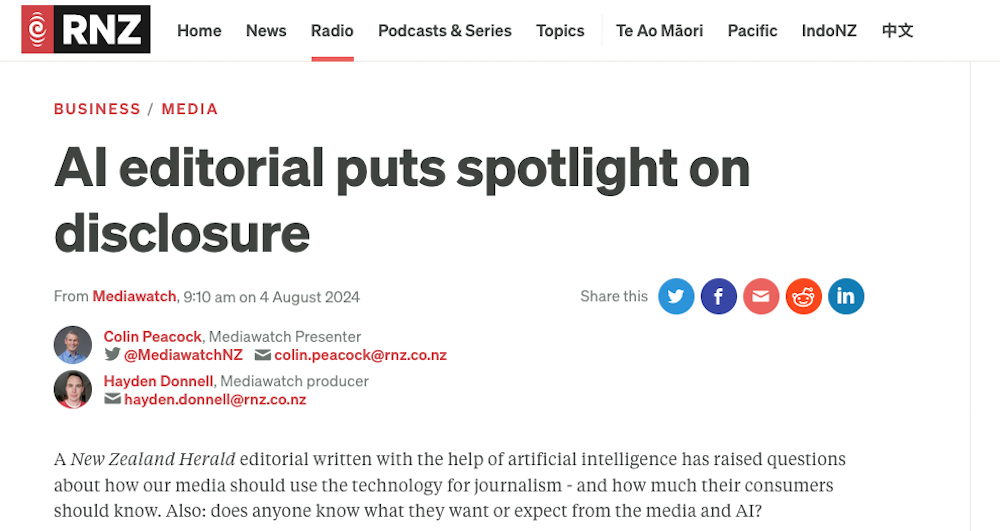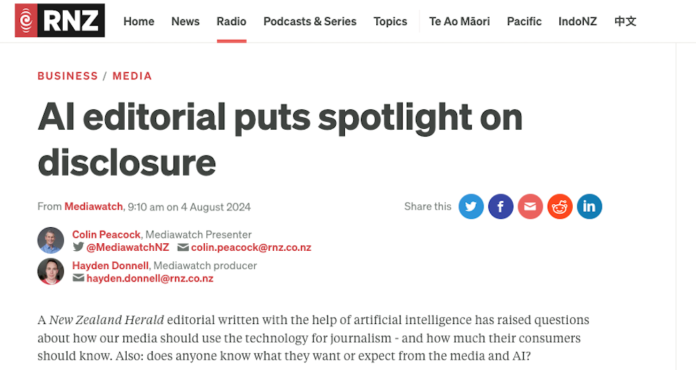Report by Dr David Robie – Café Pacific. – 
COMMENTARY: By Dr Gavin Ellis
Integrity is the most valued element of a news organisation’s reputation. Without it, it cannot expect its audience to lend credence to what it publishes or broadcasts. So, The New Zealand Herald has dealt itself an awful blow.
Its admission that it used generative AI to scrape content and then create an editorial about the All Blacks came only after it was caught out by Radio New Zealand. RNZ’s subsequent revelation that it may have found another three robot editorials in The Herald was met with sullen silence.
All the country’s largest newspaper will say its that it should have employed more “journalistic rigour”.
That is not good enough. It does not explain why the paper made the bizarre choice to employ Gen AI to create what should be its own opinion. It does not explain why there was no disclosure of its use (although to do so on an editorial should raise more red flags than a North Korean Workers Party anniversary). It does not tell us how widespread the practice is within publications owned by NZME (The Herald editorial was reprinted in its regional titles).
It does not explain why even the most basic subediting was not applied to an obviously deficient piece of writing when editorials have previously been checked and rechecked to prevent the most minor of errors. And it does not reveal what went wrong in the editorial chain of command to allow all or any of the foregoing to occur…or not.
RNZ Mediawatch’s Hayden Donnell did an excellent job in “outing” The Herald’s practice. I admit that when I read the All Blacks editorial my reaction was that it was a particularly badly written leader that had been shoved into the paper unedited. That would have been bad enough, but it never occurred to me that it might be the scribbles of a robot hand.
Donnell had the insight to put it through AI detection software and, like the Customs Service’s First Defender against drugs on Border Patrol, it returned a positive reading. It indicated it was most likely the product of Gen AI. His finding was revealed on Mediawatch last Wednesday. A follow-up fronted by Colin Peacock on Sunday’s Mediawatch revealed a further three editorials — all on sporting subjects — had returned similar readings to the first.
Peacock told listeners the publisher had declined to comment.
AI-created editorials: What in HAL’s name was the Herald thinking?
The Herald’s own disclosure of the issue to its readers was buried in Shayne Currie’s Media Insider column. Headed “AI and that NZ Herald editorial”, it was the fourth item after an interminable piece on TVNZ’s ongoing fight with former Breakfast host Kamahl Santamaria, TVNZ’s CEO paying her own way to the Olympics, and the release of the Wall Street Journal reporter held in Moscow on fabricated charges.
The item about itself assumed everyone had already caught up with the RNZ story and simply began by saying newsroom staff had been called to a meeting “to discuss use of artificial intelligence (AI), following a case in which NZME says it should have applied more “journalistic rigour” in the way AI was used to help create a recent NZ Herald editorial”.
It quoted Herald editor-in-chief (and NZME’s chief content officer-publishing) Murray Kirkness setting out the general principles on which The Herald and other publishers used artificial intelligence. He went on to say:
“I’m keen to hold another of our regular All Hands meetings next week, which will include discussion about our use of AI now and into the future.
“As always, trust and credibility are vitally important to us and will be part of the discussion.
“Next week’s session will be an opportunity for us to talk further about our use of AI and the standards we need to maintain as we use it.”
That does not signal to me — or to other Herald readers — that he accepts there is a major issue facing him and his editorial department. Much as NZME might like to minimise what has happened, this is a serious matter that requires no small amount of damage control.
That daily column headed “We say” is more than just one of the many opinion columns peppered throughout the paper. To my way of thinking, it was supposed to be the considered, intellectually rigorous view of the masthead, one from which the public might form their own opinions and draw their own conclusions.
It was also the place from which the powerful could be called to account. As such it always played a significant role in determining the integrity of the masthead and the trust that readers resided in it. That is why its production each day was the direct responsibility of the editor or deputy editor.
I have been both an editorial writer and an editor. I know, from direct experience, the rigour that must be applied to the processes in its production — from robust discussion of the subject, to determining a justified point of view, and ensuring its accuracy and quality. I have felt the weight of responsibility in its publication each day, a weight that is the greater when calling people to account. Our editorials were unsigned because they represented the view of the masthead. The editor took direct responsibility for what it said.
My mentor, and one of my predecessors as editor of The New Zealand Herald, John Hardingham, wrote in the Manual of Journalism about the delegating nature of the editorial structure. He added the following:
One duty, however, is never delegated. That is the expression of the newspapers’ opinions through its leading articles or editorials. The editor, or the deputy editor, personally chooses the daily topics for comment, defines the approach in consultation with the specialist leader writers, and sub-edits the completed work.
That signalled the significance attached to the editorial column. Even if its readership level is low compared with other parts of the newspaper, that significance is not lost on those in power, and they have learned over time that they ignore editorials at their peril. What is said in the name of the masthead may be the touchpaper that ignites a crowd.
Shayne Currie informed readers on Saturday: “Once upon a time, The Herald had a dedicated team of editorial writers, or at least senior editors who had a special focus to consider the newspaper’s opinion on daily issues. Now, the responsibility falls on a wide cross-section of staff, including journalists who might be specialists in particular areas.”
I sense this is yet another indication of NZME’s laser focus on its digital content. The print edition is a legacy medium which, like a geriatric, is offered palliative services while the real effort is devoted to those with the promise of longer life. The fact the editorial is now written by a “wide cross section” suggests (along with the truncation of letters and addition of forgettable photographs) that the company is unwilling to devote resources to the page that was once the most direct link between paper and public.
That would not be lost on staff who could then be forgiven for regarding the editorial writing assignment as a chore rather than a privilege. Using AI to write the editorial may be a manifestation of that attitude. Sadly, all of this ignores the fact that the editorial also appears in digital form and should be accorded the same status it used to enjoy in print.
Shayne Currie used an unfortunate turn of phrase in the paragraph reproduced above. He said “responsibility falls”. The duty may fall to that wide cross-section but responsibility continues to sit where it has always been — with the person at the top of the editorial tree.
As such it falls to Murray Kirkness to fix what is a deepening problem that has been created not only for The Herald and its fellow NZME publications but for the wider media as well.
The AI generated editorial disclosure is a gift from the gods for those who seek to undermine news media and other institutions. I can hear the repeated refrain: “Don’t believe what they say: It is written by a robot”.
Doubtless, it will be extrapolated to embrace the entire content of the paper: “There aren’t any reporters: It’s written by robots.” Sound implausible? If people believed the claim the country’s reporters and editors had been bribed by the Public Interest Journalism Fund, anything is possible.
The editor-in-chief will have to deal with two related issues.
The first is integrity. I have no doubt that AI can be a useful tool in researching the subject of an editorial but never in writing one. The view of the newspaper must be created by the women and men who know and understand the intrinsic values that cannot be scraped from existing data.
Murray Kirkness must give readers an ironbound guarantee that Gen AI-written editorials have stopped, and will not happen again.
The second is transparency. Artificial intelligence has an undoubted place in the future of journalism where it can have immense benefits in, for example, the “digesting” of vast amounts of data and the processing of information. However, its use must be carefully proscribed by a publicly accessible AI code of conduct, which must also set out standardised forms of guaranteed disclosure of when and how it is employed. Failure to follow the code should be a disciplinary offence that could lead to dismissal.
The Herald must show that it is putting its house in order. It is always ready to hold others accountable. It did so last year over an RNZ staff member’s “Russia-friendly edits” of stories on the war in Ukraine, and did so this year over TVNZ’s missteps with redundancies.
It’s time to hang out its own laundry and show that it intends to be whiter-than-white.
There is a lot riding on the “regular All Hands meeting” at NZME tomorrow. If it minimises or ignores the damage done, it could reap the product of a seed unintentionally sown at the top of the first New Zealand Herald editorial on 13 November 1863. It was a quotation:
“Give every man thy ear, but few thy voice.
Take each man’s censure, but reserve thy judgment.“This above all: to thine own self be true,
And it must follow, as the night the day,
Thou canst not then be false to any man.”
Sage advice, true, but we should also not lose sight of the fact that the quotation is from Act 1 Scene 3 of Hamlet – one of Shakespeare’s tragedies.
Dr Gavin Ellis holds a PhD in political studies. He is a media consultant and researcher. A former editor-in-chief of The New Zealand Herald, he has a background in journalism and communications — covering both editorial and management roles — that spans more than half a century. Dr Ellis publishes the website knightlyviews.com where this commentary was first published and it is republished by Asia Pacific Report with permission.
This article was first published on Café Pacific.









